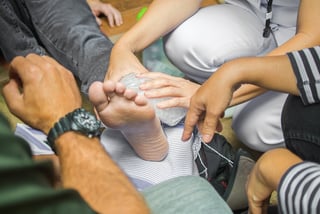Topics:
Search for topics or resources
Enter your search below and hit enter or click the search icon.
July 21st, 2016 | 3 min. read


RICE treatment, or RICE therapy, is the immediate application of Rest, Ice, Compression, and Elevation to a minor soft tissue injury like a sprain. RICE is a popular first aid treatment designed to help manage swelling, pain, and blood flow.
It has the advantage of being simple enough that anyone can use it — on the athletic field, at the site of an accident, or at home.
RICE treatment is a first-aid treatment for soft tissue injuries like sprains, strains, and bruises — for example, sprained ankles, sprained knees, or muscle strains. It's best used immediately after sustaining an injury and should be stopped within two days (48 hours).
RICE has its origins in sports medicine and is commonly used by high school athletes, weekend warriors who get hurt over-exercising, or anyone who sprains or "rolls" an ankle (one of the most common non-sports injuries).
RICE treatment involves four steps:


RICE reduces blood flow to the injured area, which keeps post-injury swelling and pain from becoming excessive.
Why is controlling swelling and pain so important?
Recent studies have shown that patients with sprains may heal faster if they begin gently exercising their injured limbs as soon as possible. In fact, some experts believe the "R" in RICE may be unnecessary after the first few minutes, and recommend using the injured limb the same day, with the help of a brace or splint.
However, too much swelling and pain can make weight-bearing and movement difficult. It's hard to walk on a sprained ankle, for example, when you're in excruciating pain or when swelling has made the joint too tender and stiff too bend.
RICE is a key part of getting patients past the initial pain-and-swelling hurdle so they can start exercising and begin healing.
Remember, RICE is first aid — not an ongoing treatment.
Note, RICE shouldn't be used indefinitely. Stop after the first two days, unless otherwise directed by a doctor. If you keep using RICE you may delay the natural inflammation and healing process.
However, if used immediately after a sprain or strain and for up to 48 hours after injury, RICE therapy tends to get people back "on their feet" faster.
If you have a sprain or strain, call Coastal Orthopedics. Located in Corpus Christi, our orthopedic specialists can examine you, assess your condition, and discuss which treatment is the right choice for you. We also offer knee conditioning, shoulder conditioning, and other programs that can help get you back into shape after injury. Telephone: 361.994.1166.
Article written by: Rob Williams, MD
Dr. Williams has been practicing orthopedic surgery in Corpus Christi since 1998. After graduating from Texas Tech hereceived his medical degree from the University of Texas at San Antonio. At the prestigious Campbell Clinic located at the University of Tennessee, Dr. Williams completed not only an Orthopedic Surgery Residency, but an additional year of Fellowship Training in Spine Surgery. Dr. Williams is dedicated to creating an excellent patient experience in the office or in the surgery suite.
Topics: